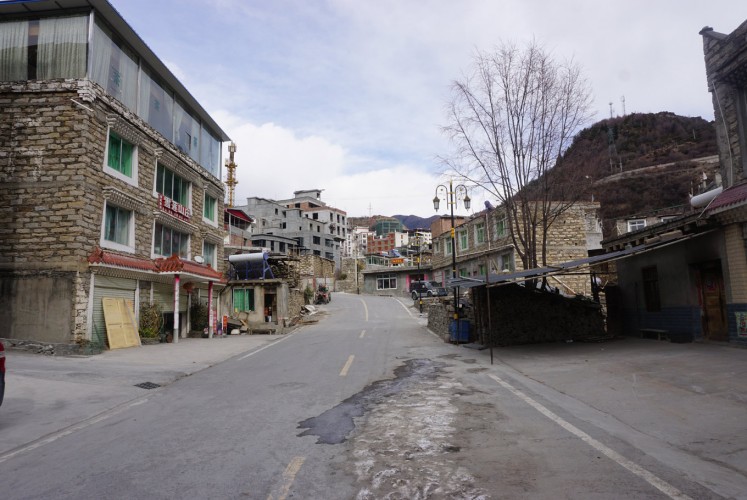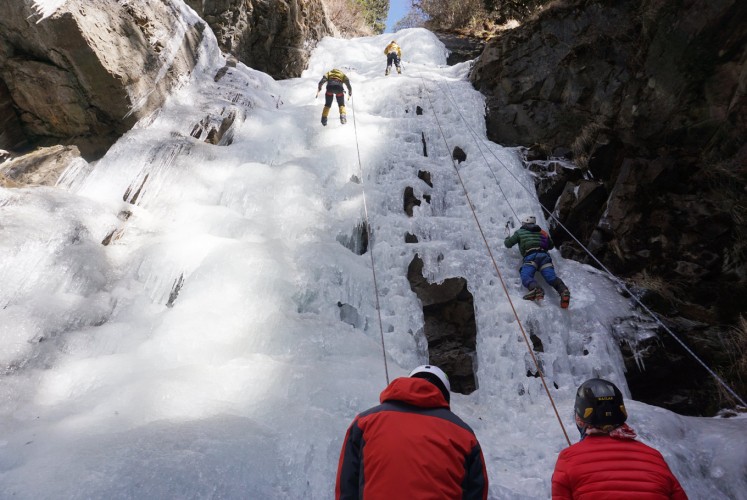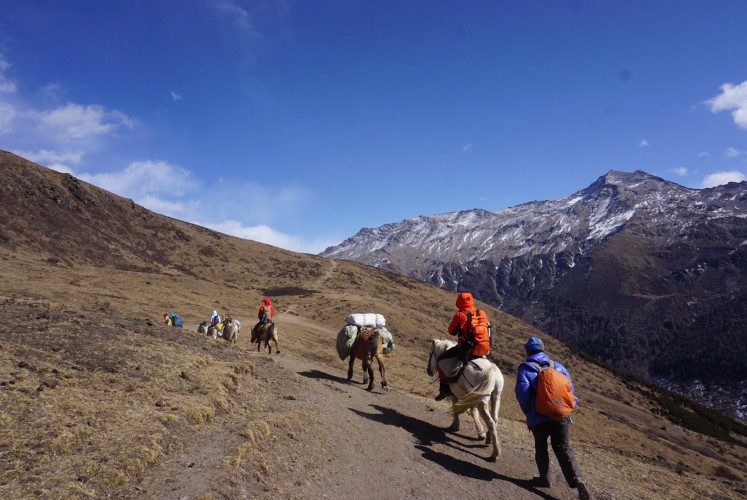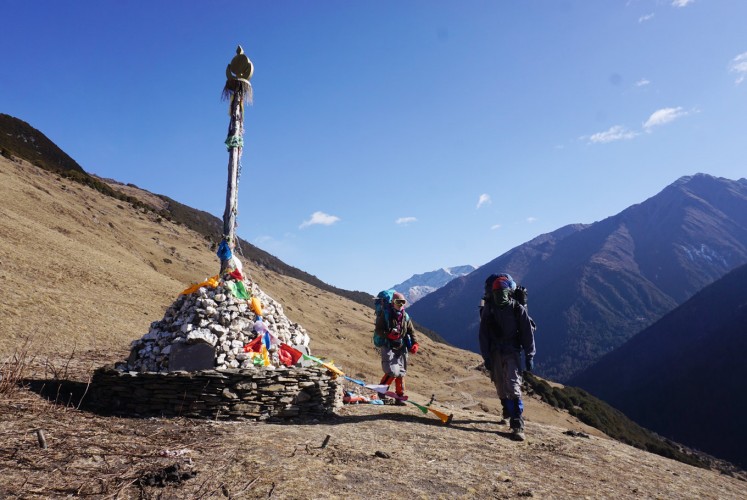Mount Siguniang: Sacred place for Tibetans, paradise for climbers
I was in the valley of Mount Siguniang, China, a sacred place for the Tibetan people and paradise for climbers.
Change Size
 Feeding time: Animals such as cows, pigs and mountain horses live outside of their natural habitat near Mount Siguniang because they are reared by local people. (JP/Rayhan Dudayev)
Feeding time: Animals such as cows, pigs and mountain horses live outside of their natural habitat near Mount Siguniang because they are reared by local people. (JP/Rayhan Dudayev)
I
drank hot water from my thermos. It warmed my body, which needed a lot of water given the altitude -- 3,300 meters above sea level.
I was in the valley of Mount Siguniang, China, a sacred place for the Tibetan people and paradise for climbers.
The temperature was -8 degrees Celsius on Jan. 24. The sun shined brightly even though it was winter. On the peaks of the towering mountains sat snow, making the scenery truly mesmerizing.
There are four peaks on Mt. Siguniang: Daguniang Feng (also known as Big Peak or first peak), Erguniang Feng (second peak), Sangungiang Feng (third peak) and Yaomei Feng (fourth peak). The highest peak, Yaomei Feng -- literally "peak of the youngest sister" -- stands at 6,250 meters and is known as the "Queen of Sichuan's peaks". Daguniang Feng, the lowest peak at 5,025 m, is known as the "peak of the oldest sister” and it is the destination I would go to, as its routes are generally considered purely for trekking.
Animals such as cows, pigs and mountain horses live outside of their natural habitat near Mount Siguniang because they are reared by local people. Their physique is unique compared to most cattle. They have thick fur, except for the pigs.
People living in the area mostly work as farmers or in tourism, with jobs that include horse porters, hiking guides, hotel managers, cooks and climbing guides. While China is dominated by the Han ethnicity at 91 percent of the population, in Siguniang live the Qiang and the Tibetan people.

As a small town, Siguniang has strong infrastructure as the Chinese government began to build highways and tunnels under the mountain to open up access in 1990, when tourists, especially climbers, began to flock to Mount Siguniang. Furthermore, various hotels are located in the town, with prices ranging from RMB 70 (US$11) to RMB 160. The prices usually include breakfast and dinner, Wi-Fi, heater, hot water and a 3x5 meter room.
Outdoor activities such as ice climbing are popular on Mt. Siguniang. Ice climbing also functions as a process of acclimatization, to familiarize climbers with altitude conditions. The levels of climbing range from easy to difficult. Climbing equipment is easy to rent around the hotel, and there are also climbing schools.

Hiking begins at an altitude of 3,300 meters. Trekkers who do not want to walk the 19 kilometers it takes to reach the Daguniang Feng shelter at 4,325 m usually camp for a night or ride horses that can carry their goods. Walking from the entrance gate of the mountain to the Daguniang Feng shelter, the lowest peak, takes five to seven hours at a leisurely pace.
Erguniang Feng peak is 250 m higher than Daguniang Feng and can be reached easily from the latter's shelter in a two-hour hike.
The walk is not as long as it seems, because trekkers will be entertained and awed by the grandeur of the mountain scenery and wildlife. From the final shelter, it takes approximately four hours to reach the summit.


Before reaching the first shelter, climbers are encouraged to go through Tibetan rituals by praying for peace on earth. The ritual is carried out by walking around a small tower with colorful flags eight times.
More than just a source of income for the Tibetan people, Mt. Siguniang is also a holy place where they worship. On the first month of the Chinese calendar, local Tibetans within hundreds of miles dress in their holiday best and ride horses with red ribbons to Mt. Siguniang for rituals.
There, a bonfire is set up and the Guozhuang dance is performed. Love toward one another is expressed through antiphonal singing and horse racing until the sun falls. (dev/kes)

Tips and access to Mount Siguniang
- The mountain is accessible through the capital of Sichuan Province, Chengdu. From Chengdu, visitors can take a bus from the Chengdu bus station to Wolong at a cost of ¥150 ($1.4) before hiring a small car to get to a hotel at the Siguniang Valley.
- It takes six hours by bus to reach Siguniangshan from the Chádiànzi bus station in Chengdu. The delightful journey winds through a 4,200-meter mountain pass with formidable views.
- The mountain can be entered at any time, whether in the winter or the summer. In winter, the temperature can reach -13 degrees Celsius, even though the sun shines brightly.
- Before climbing, it is advisable to acclimatize the body to the high-altitude environment.
- Bathing before hiking in the winter season is not advised as the body gets cold easily at cold temperatures.
- Bring climbing equipment, such as UV glasses of at least 400, a sun protector, outer and inner wear, mountain boots, gloves and tents (for those who want to camp overnight).
- Sleeping too long can reduce oxygen consumption, provoking an acute headache. Therefore, it is suggested to sleep six to eight hours per day.
- It is highly recommended to train and keep fit before going to Siguniang Mountain.
- The Shuangqiaogou entrance fee is ¥80 regularly and ¥50 in the off-season.
- The town is small enough to get to most hotels by foot.
- Siguniangshan has three central valleys, all within easy reach from Siguniangshan town.
***
Rayhan Dudayev is an adventurer, member of the University of Indonesia's Mapala organization and law researcher on maritime policy. He is passionate in free-diving and reading. Check out his Instagram at @rdudayev (https://www.instagram.com/rdudayev/).
---------------
Interested to write for thejakartapost.com? We are looking for information and opinions from experts in a variety of fields or others with appropriate writing skills. The content must be original on the following topics: lifestyle (beauty, fashion, food), entertainment, science & technology, health, parenting, social media, and sports. Send your piece to community@jakpost.com. For more information, click here.






